Sansevieria: Reproduction and Care at Home
Sansevieria is an ornamental leafy plant, which is also known to many under the names of “mother-in-law’s tongue”, “pike tail”, “leopard lily”, and “snake skin”. The plant attracts flower growers with its upright leathery leaves that have unusual patterns. Sansevierias look more impressive in group plantings, which is why they are often planted in one pot.
Sansevieria in Detail
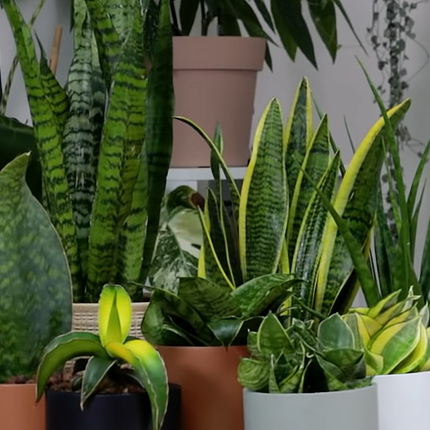
Sansevieria belongs to the Asparagus family and is an evergreen perennial. In the wild, the plant grows in Madagascar, South Africa, the subtropics and tropics of India, Southeast Asia, and the south of the United States. These useful indoor plants are very easy to grow at home; they are undemanding, so even a novice gardener can cope with their maintenance. You can buy Sansevieria online, and the urgent flower delivery in Kyiv will save you from having to transport a large flower around the city on your own. Sansevieria is so resilient that even if you go on vacation or a business trip for two weeks, it will not suffer at all and will stay just as green, bright, and blooming. It is worth noting that due to its attractive appearance and durability, Sansevieria is very popular not only among flower growers, but also among interior designers, as well as florists.
The plant has a creeping root system and dense, strong leaf plates that grow from the very base, 1 m (~3.3 ft.) long and even higher. The leaf color palette covers all sorts of shades of green and brown. There are also variegated types with inclusions, stains, and lines on the surface of the plates. During the flowering period, unremarkable cylinder-shaped inflorescences appear on the shrub, consisting of very small buds with light green petals. The flowers bloom at sunset and have a subtle vanilla scent. At the end of flowering, fruits ripen in the form of spherical berries with small seeds. However, it is worth noting that indoor Sansevierias bear fruit extremely rarely.
Types of Sansevieria
In total, about sixty varieties of Sansevieria are known to science, and all of them have differences in the shape, color, and leaf length. Only ten of them are cultivated as indoor flowers.
Sansevieria Grandis
Sansevieria grandis is a large epiphytic plant with 2-4 dense pointed-end leaves growing from its root. The dimensions of each leaf plate are 60 x 15 cm (~2 x 0.5 ft.). The color is rich green with light-green stains and stripes. The edging of the leaves has a red tint. During the flowering period, a vertical peduncle 70-80 cm (~2.3-2.6 ft.) long grows from the rosette, on which small flowers of a white-green tone with a dense sepal bloom over time.
Sansevieria Graceful (Sansevieria Gracilis)
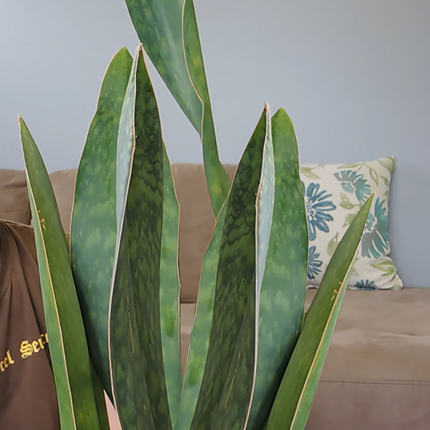
Sansevieria gracilis is a perennial herbaceous plant with fleshy, erect leaves that grow from a thick stem 5-6 cm (~0.2 ft.) high. The leaf plates are dense, rectangular, with an elongated end. They are bluish-green and decorated with transverse, fuzzy creamy spots.
Sansevieria Hyacinthoides
The plant grows up to 50 cm (~1.6 ft.). The leaves are erect, fleshy, and grow from the rosette in groups of 3 to 4. The length of the leaf plates is 15-40 cm (~0.5-1.3 ft.), and the width is 6-8 cm (~0.2-0.3 ft.). The coloring is closer to swamp-green with angular lines of a lighter tone. The narrow edging of the leaves is white or pink.
Sansevieria Dooneri
Sansevieria dooneri is a succulent plant with large basal rosettes, from which around 20 vertical leathery leaf plates grow. Their length reaches the mark of 35-40 cm (~1.1.-1.3 ft.), and the width is only 2-3 cm (~0.07-0.1 ft.). The leaf background is rich-green with darker patterns.
Sansevieria Kirkii
Sansevieria kirkii is distinguished by a sparse rosette with relatively thin green leaves with white stains and a brown-burgundy thin border. Some species with brown and reddish-brown leaf plates also exist.
Sansevieria Liberica
This succulent plant grows as a shrub and is characterized by wide rosettes with 6 erect leaves growing horizontally. The length of the leaves in mature specimens can reach 1 m (~3.3 ft.), while the width is only 8-10 cm (~0.3 ft.). The leaf tone is dark, covered with many lighter stripes and uneven spots. There is also a narrow red-brown border.
Sansevieria Trifasciata
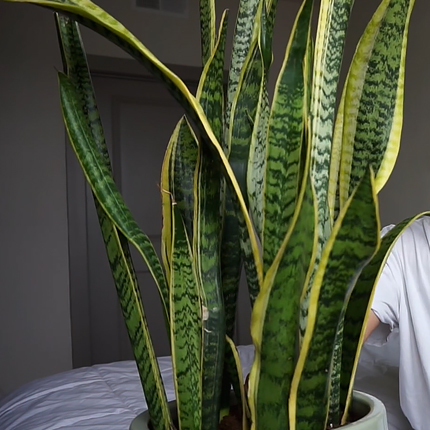
Sansevieria trifasciata is the most frequent inhabitant of our apartments. Its tall and pointed leaf blades are green with yellow edging. There are also varieties with striped leaves.
Sansevieria Cylindrica
The rich-green leaves of this plant look like long erect cylinders with parallel gray-yellow lines and strokes. The leaf plates are rosette and leathery, with sharp and narrow edges. It is worth mentioning that the leaves are actually sharp enough to cause harm. Because of this, many flower growers block the sharp parts with a sort of cork thimble. The flowering is scarce: only one sparse inflorescence grows on a shrub. The buds are light, with red narrow lines on the surface.
Sansevieria Robusta
The shrub consists of short but wide rosette green leaves with dark green lines. Robusta is divided into several subspecies:
- Black is a fast growing variety. The leaves of young shrubs are rich green, and the old ones, black and silver.
- Blue is a variety with leathery leaves in the form of a spear, which don’t grow up, but to the sides in several layers. The greens shimmer with a blue undertone and are oily to the touch.
- Black Coral are indoor flowers, the leaves of which are covered with metallic patterns
Sansevieria Futura
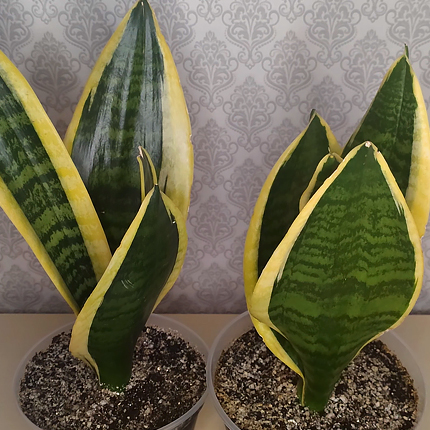
A relatively recent species created by breeders that has dense rosettes with concentrated leaves. In total, there are about 9-10 leaf plates, and they are all pale green with dark green lines and a yellowish border. Sansevieria futura is divided into several varieties:
- Futura Superba: a variety that has wide fleshy leaf plates with a yellow border
- Futura Gold: a variety with leaves that are slightly shorter than those of Futura Superba, and are painted in a green-gold tone
- Black Gold is an indoor flower with elongated thin green-blue leaves.
Sansevieria Sensation Bentel
A highly decorative plant with long vertical leaves, on the surface of which there are contrasting longitudinal white stripes. The non-striped parts have turquoise blotches. The leaf plates are leathery in their structure and grow from a wide rosette in height up to 50-60 cm (~1.6-2 ft.). Sansevieria sensation bentel is a useful indoor flower that cleans the air of pollutants. It becomes more colorful in the bright light.
Sansevieria Zeylanika
Sansevieria zeylanika is one of the favorite varieties among gardeners. At first, the flower develops thin leaves, which become denser over the years and covered with stains and spots of a silver hue. Such patterns are mainly concentrated in the center of the leaf plates. Sansevieria zeylanika can grow up to 150 cm (~5 ft.) if it receives proper care. It is light-requiring and undemanding.
Sansevieria Eilensis
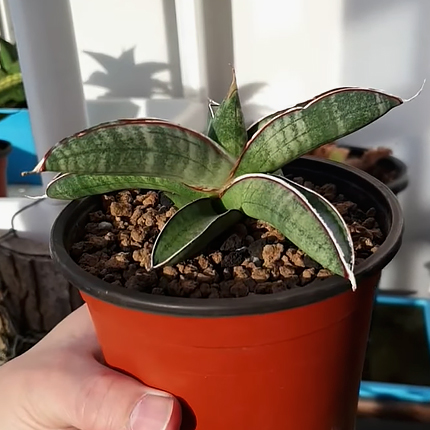
The plant is distinguished by fleshy, curved cylindrical leaves. Their color is pale blue with light-green transverse lines and darker longitudinal ones. Young specimens have a deep recess in the center of the leaves; the latter twist in its direction over the years and become tube-like.
Walking Sansevieria (Sansevieria Pinguecula)
This plant received its name due to a very unusual shape. The rosettes of this variety are formed not at the base, but on shoots growing from the main trunk. Therefore, it seems as if the shrub is making steps. The leaf plates are large, with a sharp end and a thin light border.
Growing Sansevieria
Before you start sowing and growing Sansevieria, you should learn the specifics of this process, what conditions are necessary for the plant, and what the basic requirements are. This flower is very unpretentious, so even a beginner can cope with its cultivation.
Here are some recommendations regarding the cultivation of Sansevieria:
- The flower is either not fertilized at all, or this is done only once a year. However, if you feed the plant a little more often, it will only get better.
- Sansevieria is very photophilous, so the best place for a flower pot will be a window that looks south or west. At the same time, the temperature is not particularly important, and it’s fine if the environment is cool.
- It is necessary to shade the flower at noon, as the scorching rays can cause burns on the leaves.
- The only thing that Sansevieria reacts extremely negatively to is stagnation of water in the ground. The rhizome of the plant is quite sensitive and is likely to rot from a constantly wet environment.
Propagation of Sansevieria

The plant can be propagated by root division, leaf cuttings, and side shoots. It is extremely rare to resort to seed propagation, especially since the seed material for sale is not easily found.
Propagation by Root Division
It is most expedient to divide the root of Sansevieria for subsequent reproduction in the spring, during the planned transplanting. Carefully remove the shrub from the pot, take a knife with a disinfected sharp blade, and cut the root into several parts so that each has at least one growing point. Next, these parts are planted in pre-prepared individual containers and stored in a warm place with regular watering. Propagation by root division is suitable for both simple and variegated types.
Propagation by Leaf Cuttings
Choose a mature full-grown shrub, cut off a leaf from it, and cut it into strips 4-5 cm (~0.1-0.2 ft.) long. Let the resulting strips lie in the air for a while, after which they can be planted in pots with river sand, deepening at a 45-degree angle. Containers with seedlings are covered with a transparent jar or bottle, placed on pallets, and watered using the bottom method. After about a month and a half, the leaf stalk will take root and give rise to new leaves. Once this happens, young plants can be transported to permanent containers filled with the mature Sansevieria substrate. Propagation by leaf cuttings is suitable for varieties with green leaves. The planted cuttings of variegated species will still grow simple.
Sansevieria Care
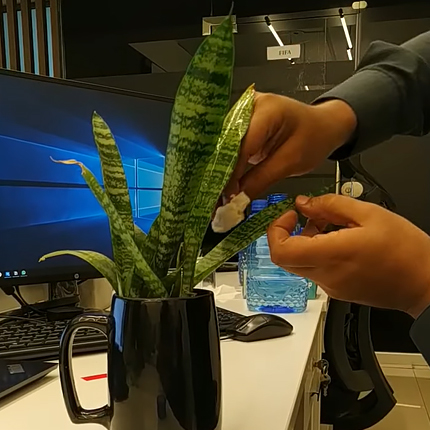
This plant is extremely tenacious and unpretentious, which will be an ideal choice for beginners, as well as those who constantly forget to care for the plants or often go on business trips.
Lighting
Among the Sansevieria, there are both light- and shade-loving indoor plants that can easily adapt to life in partial shade. The variegated types will be just as bright both in the sun and in the lamplight. It is recommended to move them to fresh air in spring and summer, not forgetting about the rain and draft protection.
Temperature
Sansevieria is a fairly thermophilic plant that feels good at temperatures of 20-25°C (68-77°F). If it gets hotter, try to ventilate the room more often. During the dormant period, the plant needs coolness (11-14°C / 51.8-57.2°F). In winter, the growth rate of Sansevieria slows down noticeably, and the shrub doesn’t need much moisture and nutrition. Don’t let the temperature drop below 10°C (50°F), otherwise your flower will get sick.
Humidity
Sansevieria is satisfied with the usual room humidity. It is not necessary to spray the plant, just to periodically clean the leaves from dust with microfiber moistened with water or arrange a warm shower for the plant. Make sure that the water is not hard; otherwise traces of lime will appear on the leaves.
Watering
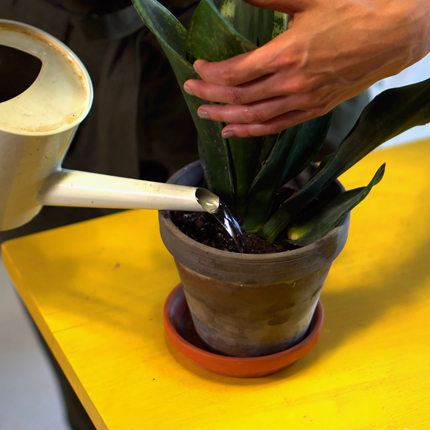
Compliance with the watering regime is one of the main conditions for the normal growth and development of the plant. Florists recommend watering it with purified or rain water. You can also use tap water, but previously settled. Cold water is not allowed. In summer, the flower is watered focusing on the drying of the upper layer of the substrate, and during the dormant period, the watering regime directly depends on the air temperature in the apartment. The cooler the room, the less frequently watering should occur.
Top Dressing
Sansevieria is fertilized in the warm season at intervals of once a month. Use mineral additives for cacti or for decorative leafy plants in liquid form. Don’t allow the nitrogenous top dressings to enter the soil, as they are unacceptable for the plant. Gardeners recommend using nutrient formulations with half the concentration indicated in the instructions. If your flower is variegated, let the concentration be three times lower. The problem is that an excess of fertilizer will lead to changes in the color of the plant and the leaves will become just green.
Transplanting
It is necessary to start transplanting Sansevieria only as a last resort, namely, when the rhizome grows and the flower becomes cramped in the old pot. As a rule, young specimens are transplanted every two years, and the old shrubs, once every three years. The plant is generally fine with transplanting; the key task is to prepare the right substrate. The ordinary garden soil will not work for Sansevieria. Give preference to store-bought soil mixtures, which consist of turf, leaf soil, and river sand in a ratio of 2:1:1, as well as of expanded clay impurities or broken brick for drainage.
Understanding that your Sansevieria no longer has enough space in the old pot is not difficult: its roots will crawl out of the drainage holes. The choice of a new container must be approached with all responsibility. Keep in mind that the pot must have thick walls (thin ones simply cannot withstand the pressure of the powerful roots and a massive aerial part). As for the size, choose wide, but not high containers with drainage at the bottom.
Pests and Diseases
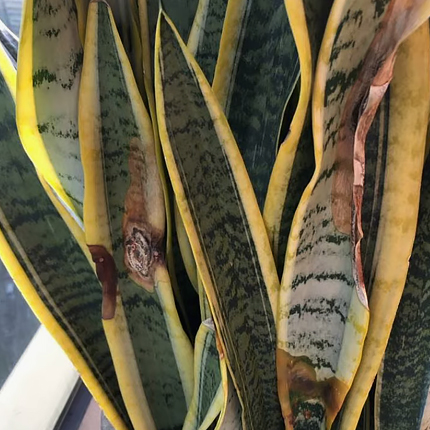
Sansevieria has a fairly strong immune system, due to which this indoor flower rarely gets sick. By its nature, the plant usually doesn’t cause problems to its owner, but only if it receives proper care. Otherwise, even Sansevieria can be attacked by parasites or a virus.
The main problems when growing this plant are as follows:
- Dark stains on the leaves. As a rule, this issue occurs if the flower is cool and watered excessively.
- Yellowing of the leaves is a sign of a lack of light or a too cramped pot.
- Leaf plates grow weakened and not vertical, but hanging. The reason lies in the lack of light.
- The leaves turn yellow from the base. Most likely, some of the moisture has accumulated in the rosette, and a fungus has developed.
- The leaves turn yellow and dry up from the ends. This means that the plant doesn’t have enough sunlight, heat, or the soil in the pot is waterlogged.
- The leaf blades wither. The reason is that the flower has not received moisture for too long.
